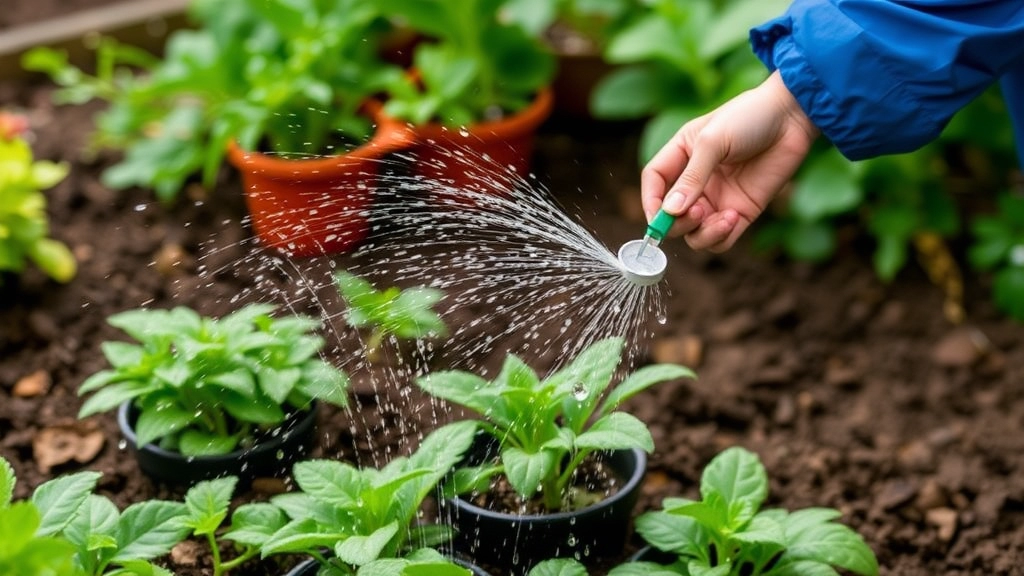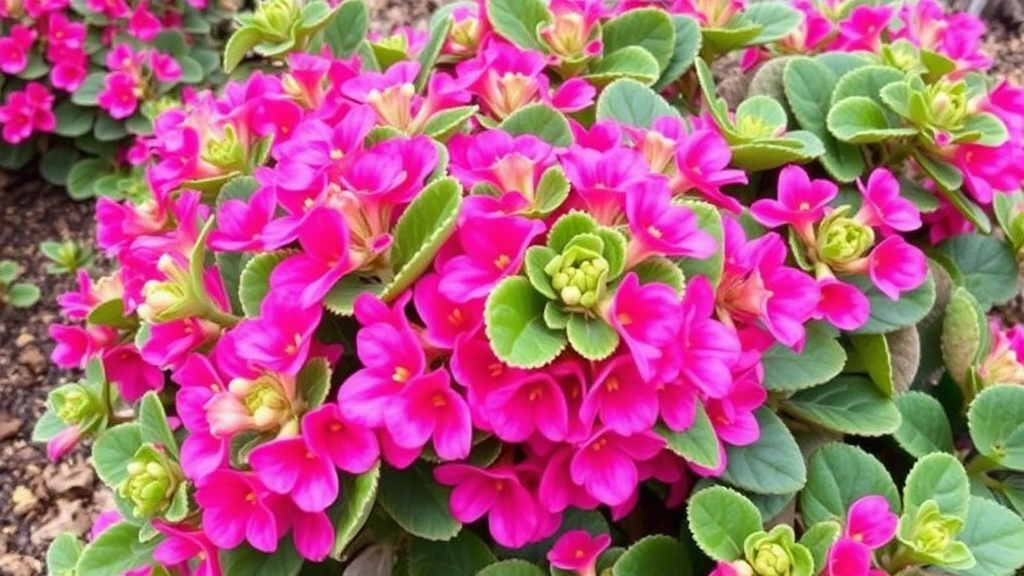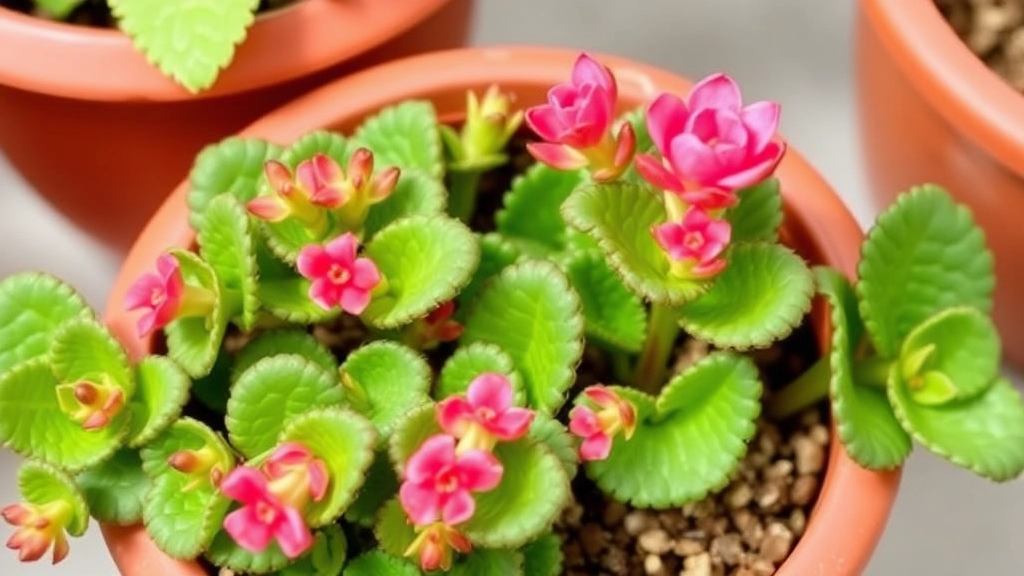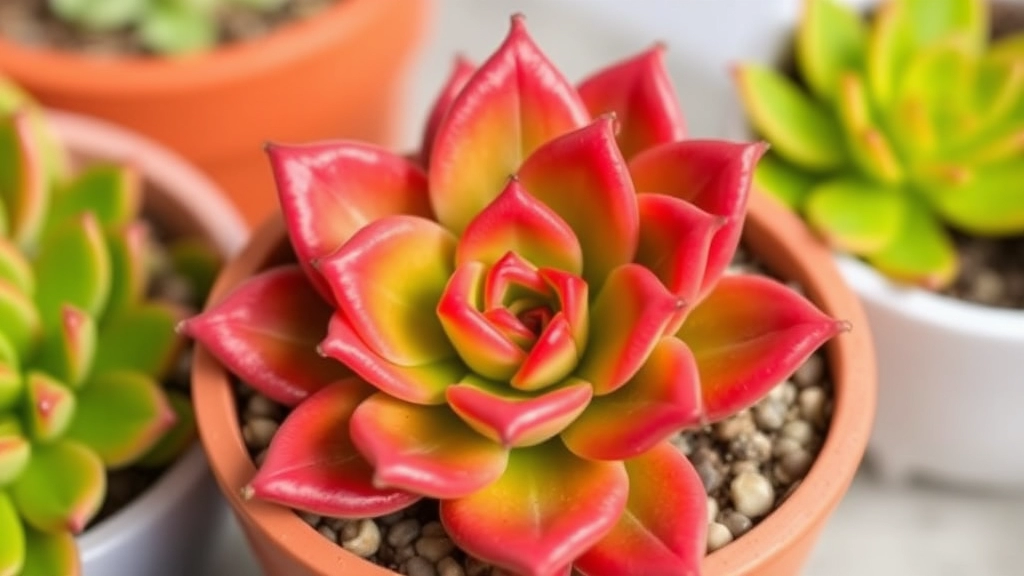How to Care for a Kalanchoe Succulent
Wondering how to care for a Kalanchoe succulent? You’re in the right place. As a fellow plant enthusiast, I’ve gathered some practical tips to keep your Kalanchoe thriving. From light conditions to watering schedules, I’ve got you covered.
Light Conditions
First, let’s talk about light. Kalanchoe succulents love bright, indirect sunlight. Too much direct light can scorch the leaves, but too little will stunt their growth. Finding that sweet spot is key.
Watering Schedule
Next up, watering: these plants prefer a “soak and dry” method. Water thoroughly, then let the soil dry out completely before the next watering. Overwatering is a common mistake, so be cautious.
Ideal Light Conditions for Kalanchoe
When it comes to nurturing a thriving Kalanchoe, one of the most pressing questions is about light conditions.
Light Requirements
Kalanchoe plants flourish in bright, indirect sunlight.
- Direct Sunlight: While Kalanchoe can tolerate some direct sunlight, too much can scorch its leaves. Aim for a few hours of morning sun if possible.
- Artificial Light: If natural light is limited, using grow lights can be an effective alternative. Position them about 12 to 18 inches above the plant for optimal growth.
- Signs of Insufficient Light: If your Kalanchoe’s leaves start to stretch or become leggy, it’s a clear indication that it needs more light.
- Ideal Placement: A south-facing window is often the best spot, but east or west-facing windows can also work well.
Light Duration
Kalanchoe benefits from around 12 to 14 hours of light each day.
Watering Schedule and Techniques

So, you’ve got your Kalanchoe all set up, but how do you keep it thriving? One of the biggest concerns for plant parents is figuring out the right watering schedule. Overwatering or underwatering can be a real bummer, leading to issues like root rot or wilting.
How Often Should You Water?
- Frequency: Generally, watering every 2-3 weeks is a good starting point.
- Seasonal Adjustments: In summer, you might need to water more frequently, while in winter, cut back to once a month.
Techniques to Master
- Check the Soil: Stick your finger about an inch into the soil. If it feels dry, it’s time to water.
- Watering Method: Water thoroughly until you see it draining out of the bottom. This ensures the roots are getting enough moisture.
- Avoid Overhead Watering: Try to water at the base of the plant. This keeps the leaves dry and helps prevent rot.
Tips for Success
- Use Room Temperature Water: Cold water can shock the plant.
- Consider the Pot: Ensure your pot has drainage holes. This is crucial for preventing water from pooling at the bottom.
Best Soil for Kalanchoe Growth
Choosing the right soil for your Kalanchoe can feel overwhelming.
What type of soil promotes healthy growth?
How can you ensure proper drainage and aeration?
These are common concerns for plant enthusiasts.
Soil Composition
Kalanchoe thrives best in well-draining soil.
Here are some key components to consider:
- Cactus Mix: A pre-packaged cactus mix is often ideal. It provides the right balance of drainage and nutrients.
- Perlite or Pumice: Adding these materials improves aeration and prevents compaction.
- Organic Matter: Incorporating a small amount of organic matter can provide essential nutrients without retaining too much moisture.
pH Levels
Kalanchoe prefers slightly acidic to neutral soil, ideally with a pH between 6.0 and 7.0.
You can test your soil’s pH using a simple kit available at garden centres.
Container Considerations
When potting your Kalanchoe, ensure the container has drainage holes.
This prevents water from accumulating at the bottom, which can lead to root rot.
Repotting Tips
If your Kalanchoe outgrows its pot, consider repotting every couple of years. For more detailed advice, check out our best soil for Kalanchoe Blossfeldiana care tips.
Use fresh soil to replenish nutrients and improve drainage. Additionally, understanding the leaf care tips and troubleshooting can help maintain the overall health of your plant.
Temperature and Humidity Requirements

When nurturing your Kalanchoe, understanding its temperature and humidity needs is vital for ensuring healthy growth and vibrant blooms. Many plant enthusiasts often wonder, “What’s the ideal temperature for my Kalanchoe?” or “How does humidity affect its growth?”
Ideal Temperature Range
Kalanchoe thrives best in a warm environment. Here are some key points to consider:
- Daytime Temperature: Aim for 20-25°C (68-77°F).
- Nighttime Temperature: A drop to around 15-18°C (59-65°F) is acceptable.
- Avoid Extreme Cold: Temperatures below 10°C (50°F) can stress the plant.
Maintaining a consistent temperature is essential. Sudden fluctuations can lead to wilting or even plant death.
Humidity Levels
Kalanchoe prefers moderate humidity levels. Here’s what you need to know:
- Ideal Humidity: 40-60% is optimal.
- Dry Conditions: While Kalanchoe can tolerate lower humidity, prolonged exposure can lead to issues like leaf drop.
- Avoid Excess Moisture: High humidity can promote fungal diseases.
If your home is particularly dry, consider using a humidity tray or a room humidifier to maintain suitable levels.
Practical Tips
- Location Matters: Place your Kalanchoe in a room with stable temperatures, away from drafts and heating vents.
- Monitor Conditions: Use a thermometer and hygrometer to keep an eye on temperature and humidity levels.
- Seasonal Adjustments: Be mindful of seasonal changes, as indoor climates can shift dramatically.
By understanding and managing the temperature and humidity for your Kalanchoe, you set the stage for robust growth and stunning flowers.
Fertilizing for Healthy Growth
Have you ever wondered why your Kalanchoe isn’t thriving as it should? Fertilizing is a crucial aspect of ensuring your plant reaches its full potential.
Understanding Fertilizer Needs
Kalanchoe plants benefit from regular feeding, especially during their growing season. Here’s what you need to know:
- Type of Fertilizer: Opt for a balanced, water-soluble fertilizer with an N-P-K ratio of 20-20-20. This ensures your plant receives essential nutrients.
- Frequency: Fertilize every 4-6 weeks during spring and summer. This aligns with their active growth period.
- Dilution: Always dilute the fertilizer to half the recommended strength. Too much can lead to root burn.
Application Techniques
Applying fertilizer correctly can make all the difference. Consider these methods:
- Watering Can: Mix the diluted fertilizer with water and use it during your regular watering schedule.
- Foliar Feeding: Lightly mist the leaves with a diluted solution. This can enhance nutrient absorption.
Signs of Nutrient Deficiency
Keep an eye out for these signs that your Kalanchoe may need more nutrients:
- Yellowing Leaves: Indicates nitrogen deficiency.
- Stunted Growth: A sign that your plant isn’t getting enough nutrients.
Seasonal Adjustments
As seasons change, so should your fertilizing routine:
- Spring/Summer: Active growth; stick to your feeding schedule.
- Autumn/Winter: Reduce or halt fertilization as the plant enters dormancy.
For more detailed care tips, check out our Optimal Care for Kalanchoe Blossfeldiana Growth guide. Additionally, if you are interested in learning about the different varieties, our Vibrant Kalanchoe Blossfeldiana Colors article is a must-read.
Pruning and Deadheading Kalanchoe

So, you’ve got your Kalanchoe thriving, and you’re wondering how to keep it looking its best.
Pruning and deadheading are essential to maintaining the health and beauty of your plant.
You might be asking, “When should I prune?” or “What’s the point of deadheading?”
Why Prune?
- Promotes Growth: Pruning encourages new growth, helping your Kalanchoe stay lush and vibrant.
- Shape Maintenance: It helps keep the plant looking tidy and balanced.
- Disease Prevention: Removing dead or damaged leaves can prevent pests and diseases.
When to Prune?
- Post-Bloom: The best time to prune is right after your Kalanchoe finishes blooming. This way, you can remove spent flowers and encourage new growth.
- Regular Checks: Keep an eye on your plant. If you notice any yellowing or wilting leaves, snip them off right away.
How to Prune?
- Use Clean Tools: Always use sharp, clean scissors or pruning shears to avoid spreading disease.
- Cut at the Base: Trim the stem just above a leaf node to encourage new growth from that point.
- Don’t Overdo It: Aim to remove about 20-30% of the plant at a time to avoid stressing it.
Deadheading Basics
Deadheading is simply the act of removing spent flowers.
Here’s why it’s important:
- Encourages Reblooming: By removing old blooms, you signal to the plant to produce new flowers.
- Improves Appearance: It keeps your plant looking fresh and vibrant.
How to Deadhead?
- Pinch or Cut: Use your fingers to pinch off the spent flower or cut it with scissors.
- Regularly Check: Make it a habit to check your plant weekly for spent blooms.
How to Encourage Kalanchoe to Rebloom
After ensuring your Kalanchoe is healthy and thriving, you may wonder how to coax it into producing those stunning blooms once more.
Understanding the Bloom Cycle
Kalanchoe plants typically bloom in cycles, often producing flowers in winter or early spring. However, with the right care, you can encourage them to rebloom throughout the year.
Key Strategies for Reblooming
- Light Exposure
Ensure your Kalanchoe receives bright, indirect sunlight for at least 6 hours a day.
If natural light is limited, consider using grow lights to supplement. - Watering Practices
Allow the soil to dry out between waterings.
Overwatering can lead to root rot, hindering bloom production. - Temperature Control
Keep your Kalanchoe in a temperature range of 15°C to 25°C.
Avoid placing it near drafts or heating vents, as temperature fluctuations can stress the plant. - Pruning and Deadheading
Regularly deadhead spent flowers to encourage new growth.
Prune back any leggy stems to promote a bushier appearance. - Dormancy Period
After the blooming period, allow the plant to rest. Reduce watering and stop fertilising for about 6 weeks.
This rest period is crucial for preparing the plant for its next bloom cycle. - Fertilisation
Use a balanced fertiliser every 4-6 weeks during the growing season.
A high-phosphorus fertiliser can be particularly effective for promoting blooms. - Stress Induction
Some growers find success by slightly stressing the plant.
Withhold water for a short period or move it to a cooler location to encourage blooming.
By implementing these strategies, you can create a nurturing environment that encourages your Kalanchoe to rebloom beautifully. For more detailed care instructions, you can refer to our Kalanchoe Blossfeldiana Flowering Period Care Tips and Ideal Temperature for Kalanchoe Blossfeldiana Growth guides.
Common Pests and Diseases to Watch For

So, you’ve got your Kalanchoe thriving, but what about those pesky pests and sneaky diseases that can throw a wrench in your plans?
Common Pests:
- Mealybugs
- These little white fluff balls love to hide in the leaf joints.
- Look for sticky residue or a cotton-like appearance.
- To tackle them, dab a cotton swab in alcohol and wipe them away.
- Aphids
- Tiny green or black bugs that suck the sap from your plant.
- If you notice distorted leaves or a sticky film, check for these guys.
- A strong blast of water can dislodge them, or you can use insecticidal soap.
- Spider Mites
- They thrive in dry conditions and leave fine webbing on your plant.
- If your Kalanchoe looks dusty or has yellowing leaves, check for these pests.
- Increase humidity around your plant and wash it with water to get rid of them.
Common Diseases:
- Powdery Mildew
- A white, powdery fungus that appears on leaves.
- It often happens in humid conditions.
- Improve air circulation and remove affected leaves.
- Root Rot
- Caused by overwatering and poor drainage.
- If your plant is wilting despite moist soil, check the roots.
- Remove the plant from the pot, trim the rotten roots, and repot in fresh soil.
- Leaf Spot
- Dark spots on leaves can indicate bacterial or fungal issues.
- Ensure good air circulation and avoid overhead watering.
Keeping an eye out for these pests and diseases can save your Kalanchoe from a lot of stress. Regular checks and prompt action are key!
Proper Potting and Repotting Practices
Are you unsure when to repot your Kalanchoe or how to choose the right pot? These concerns are common among plant enthusiasts.
Choosing the Right Pot
Selecting the right pot is crucial for your Kalanchoe’s health. Here are some tips:
- Drainage: Ensure the pot has drainage holes to prevent waterlogging.
- Size: Choose a pot that is one size larger than the current one. This encourages root growth without overwhelming the plant.
- Material: Terracotta pots are excellent for succulents as they allow for better airflow.
When to Repot
Timing is everything. Here’s when you should consider repotting your Kalanchoe:
- Root Bound: If roots are growing out of the drainage holes, it’s time for a new pot.
- Soil Degradation: If the soil looks compacted or depleted, a fresh mix can rejuvenate your plant.
- Seasonal Changes: Early spring is the best time to repot, as it aligns with the plant’s active growth period.
Repotting Steps
Follow these steps for a successful repotting experience:
- Prepare the New Pot: Add a layer of fresh soil at the bottom.
- Remove the Plant: Gently take your Kalanchoe out of its old pot, being careful not to damage the roots.
- Inspect the Roots: Trim any dead or rotting roots before placing the plant in the new pot.
- Fill with Soil: Position the plant and fill in with soil, leaving some space at the top.
- Water Sparingly: After repotting, wait a week before watering to help the plant adjust.
By following these proper potting and repotting practices, your Kalanchoe will thrive in its new environment. For more detailed care tips, check out our guide on growing and caring for flowering Kalanchoe Blossfeldiana and learn about the best soil for Kalanchoe Blossfeldiana.
How to Propagate Kalanchoe

So, you’re loving your Kalanchoe and want to multiply its beauty? You’re not alone! Many plant enthusiasts want to know how to propagate Kalanchoe successfully. It’s easier than you might think, and I’m here to share some simple steps to get you started.
Methods of Propagation
- Leaf Cuttings
- Choose a healthy leaf.
- Cut it off cleanly with a sharp knife.
- Let the cut end dry for a day or two to form a callus.
- Place it in well-draining soil and water sparingly until roots develop.
- Stem Cuttings
- Snip a healthy stem with a few leaves attached.
- Allow it to callus for a day.
- Insert the cut end into soil, keeping it moist (but not soggy).
- Offsets
- Look for small plants (offsets) growing around the base of the parent plant.
- Gently remove them, ensuring some roots are attached.
- Plant them in their own pots with suitable soil.
Tips for Successful Propagation
- Timing: Spring is the best time to propagate Kalanchoe.
- Environment: Keep the cuttings in a warm, bright spot but out of direct sunlight.
- Watering: Water lightly; too much can cause rot.
- Patience: It may take a few weeks for roots to form, so don’t rush it!
Common Mistakes to Avoid
- Overwatering: This is a killer for Kalanchoe cuttings.
- Too Much Sun: Direct sunlight can scorch new cuttings.
- Ignoring Humidity: If your home is very dry, consider a humidity tray or misting.
Seasonal Care: Adapting to Indoor and Outdoor Conditions
As we dive deeper into caring for your Kalanchoe, understanding how to adapt your care routine based on the seasons is crucial. Seasonal changes can significantly impact your plant’s growth and blooming potential.
Indoor Care
- Winter:
- Light: Position your Kalanchoe near a south-facing window to maximise sunlight.
- Watering: Reduce watering frequency; the plant needs less moisture during dormancy.
- Spring:
- Light: Increase exposure to bright, indirect light as growth resumes.
- Watering: Gradually increase watering, ensuring the soil dries out between sessions.
- Summer:
- Light: Protect from harsh afternoon sun; consider moving it to a shadier spot.
- Humidity: Maintain moderate humidity; avoid overly humid areas.
- Autumn:
- Light: Ensure it receives ample light to prepare for the winter months.
- Watering: Begin to taper off watering as temperatures drop.
Outdoor Care
- Spring:
- Transition: Gradually acclimatise your Kalanchoe to outdoor conditions once the frost has passed.
- Location: Choose a spot with bright, indirect sunlight.
- Summer:
- Heat: Shield your plant from extreme heat; consider partial shade during peak hours.
- Watering: Increase frequency but ensure proper drainage.
- Autumn:
- Preparation: As temperatures cool, start bringing your Kalanchoe indoors if it’s in a pot.
- Light: Ensure it continues to receive adequate light during the transition.
- Winter:
- Protection: If left outdoors, ensure it’s in a sheltered location to avoid frost damage.
- Watering: Cut back significantly; the plant requires minimal moisture.
Tips for Long-lasting Blooms
So, you’ve got your Kalanchoe blooming beautifully, but how do you keep those vibrant flowers around for as long as possible?
Let’s dive into some practical tips that can help you enjoy those stunning blooms longer.
FAQs on How to Care for a Kalanchoe Succulent
How often should I water my Kalanchoe?
Generally, watering every 2-3 weeks is a good starting point. During summer, you might need to water more frequently, while in winter, you can cut back to once a month.
What is the best way to water a Kalanchoe?
Water thoroughly until you see it draining out of the bottom. This ensures the roots are getting enough moisture. Avoid overhead watering and try to water at the base of the plant to keep the leaves dry and prevent rot.
What temperature is ideal for Kalanchoe?
Kalanchoe thrives best in a warm environment. Aim for daytime temperatures of 20-25°C (68-77°F) and nighttime temperatures around 15-18°C (59-65°F). Avoid temperatures below 10°C (50°F) as they can stress the plant.
How much humidity does a Kalanchoe need?
Kalanchoe prefers moderate humidity levels, ideally between 40-60%. While it can tolerate lower humidity, prolonged exposure can lead to issues like leaf drop. High humidity can promote fungal diseases, so avoid excess moisture.
When and how should I prune my Kalanchoe?
The best time to prune is right after your Kalanchoe finishes blooming. Use sharp, clean scissors or pruning shears and trim the stem just above a leaf node. Aim to remove about 20-30% of the plant at a time to avoid stressing it.
Why is deadheading important for Kalanchoe?
Deadheading, or removing spent flowers, encourages the plant to produce new blooms and keeps it looking fresh and vibrant. Regularly check your plant for spent blooms and pinch or cut them off.
What are common pests that affect Kalanchoe?
Common pests include mealybugs, aphids, and spider mites. Mealybugs appear as white fluff balls, aphids are tiny green or black bugs, and spider mites leave fine webbing on the plant. Regular checks and prompt action can help manage these pests.
How do I deal with common diseases in Kalanchoe?
Common diseases include powdery mildew, root rot, and leaf spot. Improve air circulation and remove affected leaves for powdery mildew, avoid overwatering to prevent root rot, and ensure good air circulation to avoid leaf spot.
What are the methods to propagate Kalanchoe?
You can propagate Kalanchoe through leaf cuttings, stem cuttings, or offsets. For leaf cuttings, let the cut end dry for a day or two before planting. For stem cuttings, allow them to callus for a day before planting. For offsets, gently remove them with some roots attached and plant them in their own pots.
What are some tips for successful Kalanchoe propagation?
Spring is the best time to propagate Kalanchoe. Keep the cuttings in a warm, bright spot but out of direct sunlight. Water lightly and be patient, as it may take a few weeks for roots to form.
What common mistakes should I avoid when propagating Kalanchoe?
Avoid overwatering, exposing the cuttings to direct sunlight, and ignoring humidity levels. Overwatering can cause rot, direct sunlight can scorch new cuttings, and low humidity can hinder root development.
References
-
Kalanchoe Care Guide
-
How to Care for a Kalanchoe Plant
-
Kalanchoe: How to Grow and Care for Kalanchoe Plants
